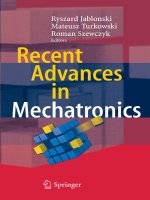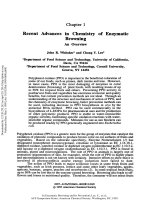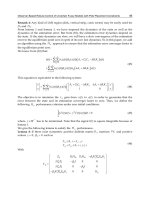recent advances in applied probability - springer
Bạn đang xem bản rút gọn của tài liệu. Xem và tải ngay bản đầy đủ của tài liệu tại đây (12.98 MB, 513 trang )
TeAM
YYePG
Digitally signed by TeAM YYePG
DN: cn=TeAM YYePG, c=US,
o=TeAM YYePG, ou=TeAM
YYePG, email=
Reason: I attest to the accuracy
and integrity of this document
Date: 2005.05.28 08:57:47 +08'00'
Recent Advances in Applied Probability
This page intentionally left blank
Recent Advances in Applied Probability
Edited by
RICARDO BAEZA-YATES
Universidad de Chile, Chile
JOSEPH GLAZ
University of Connecticut, USA
HENRYK GZYL
Universidad Simón Bolívar, Venezuela
JÜRGEN HÜSLER
University of Bern, Switzerland
JOSÉ LUIS PALACIOS
Universidad Simón Bolívar, Venezuela
Springer
eBook ISBN: 0-387-23394-6
Print ISBN: 0-387-23378-4
Print ©2005 Springer Science + Business Media, Inc.
All rights reserved
No part of this eBook may be reproduced or transmitted in any form or by any means, electronic,
mechanical, recording, or otherwise, without written consent from the Publisher
Created in the United States of America
Boston
©2005 Springer Science + Business Media, Inc.
Visit Springer's eBookstore at:
and the Springer Global Website Online at:
Contents
Preface
Acknowledgments
Modeling Text Databases
Ricardo Baeza-Yates, Gonzalo Navarro
1.1
1.2
1.3
1.4
1.5
1.6
1.7
Introduction
Modeling a Document
Relating the Heaps’ and Zipf’s Law
Modeling a Document Collection
Models for Queries and Answers
Application: Inverted Files for the Web
Concluding Remarks
Acknowledgments
Appendix
References
An Overview of Probabilistic and Time Series Models in Finance
Alejandro Balbás, Rosario Romera, Esther Ruiz
2.1
2.2
2.3
2.4
2.5
Introduction
Probabilistic models for finance
Time series models
Applications of time series to financial models
Conclusions
References
Stereological estimation of the rose of directions from the rose of intersections
Viktor Beneš, Ivan Sax
3.1
3.2
An analytical approach
Convex geometry approach
Acknowledgments
References
Approximations for Multiple Scan Statistics
Jie Chen, Joseph Glaz
4.1
Introduction
xi
xiii
1
1
3
7
8
10
14
20
21
21
24
27
27
28
38
46
55
55
65
66
73
95
95
97
97
vi
RECENTS ADVANCES IN APPLIED PROBABILITY
4.2
4.3
4.4
4.5
The One Dimensional Case
The Two Dimensional Case
Numerical Results
Concluding Remarks
98
References
Krawtchouk polynomials and Krawtchouk matrices
Philip Feinsilver, Jerzy Kocik
5.1
5.2
5.3
5.4
5.5
5.6
5.7
What are Krawtchouk matrices
Krawtchouk matrices from Hadamard matrices
Krawtchouk matrices and symmetric tensors
Ehrenfest urn model
Krawtchouk matrices and classical random walks
“Kravchukiana” or the World of Krawtchouk Polynomials
Appendix
References
An Elementary Rigorous Introduction to Exact Sampling
F. Friedrich, G. Winkler, O. Wittich, V. Liebscher
6.1
6.2
6.3
6.4
6.5
Introduction
Exact Sampling
Monotonicity
Random Fields and the Ising Model
Conclusion
Acknowledgment
References
On the different extensions of the ergodic theorem of information theory
Valerie Girardin
7.1
7.2
7.3
7.4
Introduction
Basics
The theorem and its extensions
Explicit expressions of the entropy rate
References
101
104
106
113
115
115
118
122
126
129
133
137
140
143
144
148
157
159
160
161
161
163
163
164
170
175
177
181
182
183
185
186
188
191
192
192
Dynamic stochastic models for indexes and thesauri, identification clouds,
and information retrieval and storage
Michiel Hazewinkel
8.1
8.2
8.3
8.4
8.5
8.6
8.7
8.8
Introduction
A First Preliminary Model for the Growth of Indexes
A Dynamic Stochastic Model for the Growth of Indexes
Identification Clouds
Applicatio
n
1: Automatic Key Phrase Assignment
Applicatio
n
2: Dialogue Mediated Information Retrieval
Applicatio
n
3: Distances in Information Spaces
Applicatio
n
4: Disambiguation
Contents
vii
8.9
8.10
8.11
8.12
8.13
8.14
8.15
8.16
8.17
8.18
8.19
8.20
Application 5. Slicing Texts
Weights
Application 6. Synonyms
Application 7. Crosslingual IR
Application 8. Automatic Classification
Application 9. Formula Recognition
Context Sensitive IR
Models for ID Clouds
Automatic Generation of Identification Clouds
Multiple Identification Clouds
More about Weights. Negative Weights
Further Refinements and Issues
193
194
196
196
197
197
199
199
200
200
201
202
203
205
205
208
211
216
221
223
223
226
231
233
238
241
241
244
252
263
267
267
269
269
271
271
References
Stability and Optimal Control for Semi-Markov Jump Parameter
Linear Systems
Kenneth J. Hochberg, Efraim Shmerling
9.1
9.2
9.3
9.4
Introduction
Stability conditions for semi-Markov systems
Optimization of continuous control systems with semi-Markov co-
efficients
Optimization of discrete control systems with semi-Markov coeffi-
cients
References
Statistical Distances Based on Euclidean Graphs
R. Jiménez, J. E. Yukich
10.1
10.2
10.3
10.4
Introduction and background
The nearest neighbor and main results
Statistical distances based on Voronoi cells
The objective method
References
Implied Volatility: Statics, Dynamics, and Probabilistic Interpretation
Roger W. Lee
11.1
11.2
11.3
11.4
Introduction
Probabilistic Interpretation
Statics
Dynamics
Acknowledgments
References
On the Increments of the Brownian Sheet
José R. León, Oscar Rondón
12.1
12.2
12.3
Introduction
Assumptions and Notations
Results
viii
RECENTS ADVANCES IN APPLIED PROBABILITY
12.4 Proofs
Appendix
273
277
278
References
279
279
282
283
286
290
292
296
296
299
299
301
303
306
311
313
314
317
326
326
329
329
330
333
335
336
342
346
348
351
351
353
361
365
Compound Poisson Approximation with Drift for Stochastic Additive
Functionals with Markov and Semi-Markov Switching
Vladimir S. Korolyuk, Nikolaos Limnios
13.1
13.2
13.3
13.4
13.5
13.6
Introduction
Preliminaries
Increment Process
Increment Process in an Asymptotic Split Phase Space
Continuous Additive Functional
Scheme of Proofs
Acknowledgments
References
Penalized Model Selection for Ill-posed Linear Problems
CarenneLudeña, Ricardo Ríos
14.1
14.2
14.3
14.4
14.5
14.6
14.7
14.8
Introduction
Penalized model selection [Barron, Birgé & Massart, 1999]
Minimax estimation for ill posed problems
Penalized model selection for ill posed linear problems
Bayesian interpretation
penalization
Numerical examples
Appendix
Acknowledgments
References
The Arov-Grossman Model and Burg’s Entropy
J.G. Marcano, M.D. Morán
15.1
15.2
15.3
15.4
15.5
15.6
15.7
Introduction
Notations and preliminaries
Levinson’s Algorithm and Schur’s Algorithm
The Christoffel-Darboux formula
Description of all spectrums of a stationary process
On covariance’s extension problem
Burg’s Entropy
References
Recent Results in Geometric Analysis Involving Probability
Patrick
McDonald
16.1
16.2
16.3
16.4
Introduction
Notation and Background Material
The geometry of small balls and tubes
Spectral Geometry
Contents
ix
16.5
16.6
16.7
16.8
Isoperimetric Conditions and Comparison Geometry
Minimal Varieties
Harmonic Functions
Hodge Theory
375
382
383
388
391
397
398
405
406
406
412
418
422
424
425
426
427
427
430
431
433
436
441
452
455
455
456
458
464
472
482
490
491
491
495
References
Dependence or Independence of the Sample Mean and Variance In Non-IID
or Non-Normal Cases and the Role or Some Tests of Independence
Nitis Mukhopadhyay
17.1
17.2
17.3
17.4
17.5
17.6
17.7
17.8
Introduction
A Multivariate Normal Probability Model
A Bivariate Normal Probability Model
Bivariate Non-Normal Probability Models: Case I
Bivariate Non-Normal Probability Models: Case II
A Bivariate Non-Normal Population: Case III
Multivariate Non-Normal Probability Models
Concluding Thoughts
Acknowledgments
References
Optimal Stopping Problems for Time-Homogeneous Diffusions: a Review
Jesper Lund Pedersen
18.1
18.2
18.3
18.4
18.5
18.6
Introduction
Formulation of the problem
Excessive and superharmonic functions
Characterization of the value function
The free-boundary problem and the principle of smooth fit
Examples and applications
References
Criticality in epidemics:
The mathematics of sandpiles explains uncertainty in epidemic outbreaks
Nico Stollenwerk
19.1
19.2
19.3
19.4
19.5
19.6
19.7
Introduction
Basic epidemiological model
Measles around criticality
Meningitis around criticality
Spatial stochastic epidemics
Directed percolation and path integrals
Summary
Acknowledgments
References
Index
This page intentionally left blank
Preface
The possibility of the present collection of review papers came up the last
day of IWAP 2002. The idea was to gather in a single volume a sample of the
many applications of probability.
As a glance at the table of contents shows, the range of covered topics is
wide, but it sure is far away of being close to exhaustive.
Picking up a name for this collection not easier than deciding on a criterion
for ordering the different contributions. As the word ‘advances” suggests, each
paper represents a further step toward understanding a class of problems. No
last word on any problem is said, no subject is closed.
Even though there are some overlaps in subject matter, it does not seem
sensible to order this eclectic collection except by chance, and such an order
is already implicit in a lexicographic ordering by first author’s last name: No-
body (usually, that is) chooses a last name, does she/he? So that is how we
settled the matter of ordering the papers.
We thank the authors for their contribution to this volume.
We also thank John Martindale, Editor, Kluwer Academic Publishers, for
inviting us to edit this volume and for providing continual support and encour-
agement.
This page intentionally left blank
Acknowledgments
The editors thank the Cyted Foundation, Institute of Mathematical Statis-
tics, Latin American Regional Committee of the Bernoulli Society, National
Security Agency and the University of Simon Bolivar for co-sponsoring IWAP
2002 and for providing financial support for its participants.
The editors warmly thank Alfredo Marcano of Universidad Central de Ve-
nezuela for having taken upon his shoulders the painstaking job of rendering
the different idiosyncratic contributions into a unified format.
This page intentionally left blank
MODELING TEXT DATABASES
Ricardo Baeza-Yates
Depto. de Ciencias de la Computación
Universidad de Chile
Casilla 2777, Santiago, Chile
Gonzalo Navarro
Depto. de Ciencias de la Computación
Universidad de Chile
Casilla 2777, Santiago, Chile
Abstract We present a unified view to models for text databases, proving new relations
between empirical and theoretical models. A particular case that we cover is the
Web. We also introduce a simple model for random queries and the size of their
answers, giving experimental results that support them. As an example of the
importance of text modeling, we analyze time and space overhead of inverted
files for the
Web.
1.1
Introduction
Text databases are becoming larger and larger, the best example being the
World Wide Web (or just Web). For this reason, the importance of the infor-
mation retrieval (IR) and related topics such as text mining, is increasing every
day [Baeza-Yates & Ribeiro-Neto, 1999]. However, doing experiments in large
text collections is not easy, unless the Web is used. In fact, although reference
collections such as TREC [Harman, 1995] are very useful, their size are sev-
eral orders of magnitude smaller than large databases. Therefore, scaling is an
important issue. One partial solution to this problem is to have good models
of text databases to be able to analyze new indices and searching algorithms
before making the effort of trying them in a large scale. In particular if our
application is searching the Web. The goals of this article are two fold: (1) to
present in an integrated manner many different results on how to model nat-
RECENT
S
ADVANCES IN APPLIED PROBABILITY
2
ural language text and document collections, and (2) to show their relations,
consequences, advantages, and drawbacks.
We can distinguish three types of models: (1) models for static databases,
(2) models for dynamic databases, and (3) models for queries and their an-
swers. Models for static databases are the classical ones for natural language
text. They are based in empirical evidence and include the number of differ-
ent words or vocabulary (Heaps’ law), word distribution (Zipf’s law), word
length, distribution of document sizes, and distribution of words in documents.
We formally relate the Heaps’ and Zipf’s empirical laws and show that they
can be explained from a simple finite state model.
Dynamic databases can be handled by extensions of static models, but there
are several issues that have to be considered. The models for queries and their
answers have not been formally developed until now. Which are the correct
assumptions? What is a random query? How many occurrences of a query are
found? We propose specific models to answer these questions.
As an example of the use of the models that we review and propose, we
give a detailed analysis of inverted files for the Web (the index used in most
Web search engines currently available), including their space overhead and
retrieval time for exact and approximate word queries. In particular, we com-
pare the trade-off between document addressing (that is, the index references
Web pages) and block addressing (that is, the index references fixed size log-
ical blocks), showing that having documents of different sizes reduces space
requirements in the index but increases search times if the blocks/documents
have to be traversed. As it is very difficult to do experiments on the Web as a
whole, any insight from analytical models has an important value on its own.
For the experiments done to backup our hypotheses, we use the collections
contained in
TREC-2 [Harman, 1995], especially the Wall Street Journal (WSJ)
collection, which contains 278 files of almost 1 Mb each, with a total of 250
Mb of text. To mimic common IR scenarios, all the texts were transformed to
lower-case, all separators to single spaces (except line breaks); and stopwords
were eliminated (words that are not usually part of query, like prepositions,
adverbs, etc.). We are left with almost 200 Mb of filtered text. Throughout the
article we talk in terms of the size of the filtered text, which takes 80% of the
original text. To measure the behavior of the index as grows, we index the
first 20 Mb of the collection, then the first 40 Mb, and so on, up to 200 Mb.
For the Web results mentioned, we used about 730 thousand pages from the
Chilean Web comprising 2.3Gb of text with a vocabulary of 1.9 million words.
This article is organized as follows. In Section 2 we survey the main em-
pirical models for natural language texts, including experimental results and
a discussion of their validity. In Section 3 we relate and derive the two main
empirical laws using a simple finite state model to generate words. In Sections
4 and 5 we survey models for document collections and introduce new models
Modeling Text Databases
3
for random user queries and their answers, respectively. In Section 6 we use
all these models to analyze the space overhead and retrieval time of different
variants of inverted files applied to the Web. The last section contains some
conclusions and future work directions.
1.2
Modeling a Document
In this section we present distributions for different objects in a document.
They include characters, words (unique and total) and their length.
1.2.1
Distribution of Characters
Text is composed of symbols from a finite alphabet. We can divide the sym-
bols in two disjoint subsets: symbols that separate words and symbols that
belong to words. It is well known that symbols are not uniformly distributed.
If we consider just letters (a to z), we observe that vowels are usually more
frequent than most consonants (e.g., in English, the letter ‘e’ has the highest
frequency.) A simple model to generate text is the Binomial model. In it, each
symbol is generated with certain fixed probability. However, natural language
has a dependency on previous symbols. For example, in English, a letter ‘f’
cannot appear after a letter ‘c’ and vowels, or certain consonants, have a higher
probability of occurring after ‘c’. Therefore, the probability of a symbol de-
pends on previous symbols. We can use a finite-context or Markovian model
to reflect this dependency. The model can consider one, two or more letters to
generate the next symbol. If we use letters, we say that it is a -order model
(so the Binomial model is considered a 0-order model). We can use these mod-
els taking words as symbols. For example, text generated by a 5-order model
using the distribution of words in the Bible might make sense (that is, it can
be grammatically correct), but will be different from the original [Bell, Cleary
& Witten, 1990, chapter 4]. More complex models include finite-state models
(which define regular languages), and grammar models (which define context
free and other languages). However, finding the correct complete grammar for
natural languages is still an open problem.
For most cases, it is better to use a Binomial distribution because it is simpler
(Markovian models are very difficult to analyze) and is close enough to reality.
For example, the distribution of characters in English has the same average
value of a uniform distribution with 15 symbols (that is, the probability of
two letters being equal is about 1/15 for filtered lowercase text, as shown in
Table 1).
1.2.2
Vocabulary Size
What is the number of distinct words in a document? This set of words is re-
ferred to as the document vocabulary. To predict the growth of the vocabulary
4
RECENTS ADVANCES IN APPLIED PROBABILITY
size in natural language text, we use the so called Heaps’ Law [Heaps, 1978],
which is based on empirical results. This is a very precise law which states that
the vocabulary of a text of words is of size where K
and depend on the particular text. The value of K is normally between 10
and 100, and is a positive value less than one. Some experiments [Araújo et
al, 1997; Baeza-Yates & Navarro,1999] on the TREC-2 collection show that
the most common values for are between 0.4 and 0.6 (see Table 1). Hence,
the vocabulary of a text grows sub-linearly with the text size, in a proportion
close to its square root. We can also express this law in terms of the number of
words, which would change K.
Notice that the set of different words of a language is fixed by a constant
(for example, the number of different English words is finite). However, the
limit is so high that it is much more accurate to assume that the size of the
vocabulary is
instead of O(1) although the number should stabilize for
huge enough texts. On the other hand, many authors argue that the number
keeps growing anyway because of the typing or spelling errors.
How valid is the Heaps’ law for small documents? Figure 1 shows the evo-
lution of the value as the text collection grows. We show its value for up to
1 Mb (counting words). As it can be seen, starts at a higher value and con-
verges to the definitive value as the text grows. For 1 Mb it has almost reached
its definitive value. Hence, the Heaps’ law holds for smaller documents but the
value is higher than its asymptotic limit.
Figure 1. Value of as the text grows. We added at the end the value for the 200 Mb
collection.
For our Web data, the value of is around 0.63. This is larger than for
English text for several reasons. Some of them are spelling mistakes, multiple
languages, etc.
Modeling Text Databases
5
1.2.3
Distribution of Words
How are the different words distributed inside each document?. An approx-
imate model is the Zipf’s Law [Zipf, 1949; Gonnet & Baeza-Yates, 1991],
which attempts to capture the distribution of the frequencies (that is, number
of occurrences) of the words in the text. The rule states that the frequency
of the most frequent word is times that of the most frequent word.
This implies that in a text of words with a vocabulary of V words, the
most frequent word appears times, where is the harmonic
number of order of V, defined as
so that the sum of all frequencies is The value of depends on the text.
In the most simple formulation, and therefore
However, this simplified version is very inexact, and the case (more
precisely, between 1.7 and 2.0, see Table 1) fits better the real data [Araújo
et al, 1997]. This case is very different, since the distribution is much more
skewed, and Experimental data suggests that a better model is
where c is an additional parameter and is such that all frequencies
add to This is called a Mandelbrot distribution [Miller, Newman & Fried-
man, 1957; Miller, Newman & Friedman, 1958]. This distribution is not used
because its asymptotical effect is negligible and it is much harder to deal with
mathematically.
It is interesting to observe that if, instead of taking text words, we take
no Zipf-like distribution is observed. Moreover, no good model is
known for this case [Bell, Cleary & Witten, 1990, chapter 4]. On the other
hand, Li [Li, 1992] shows that a text composed of random characters (separa-
tors included) also exhibits a Zipf-like distribution with smaller and argues
that the Zipf distribution appears because the rank is chosen as an indepen-
dent variable. Our results relating the Zipf’s and Heaps’ law (see next sec-
tion), agree with that argument, which in fact had been mentioned well before
[Miller, Newman & Friedman, 1957].
Since the distribution of words is very skewed (that is, there are a few hun-
dred words which take up 50% of the text), words that are too frequent, such
as stopwords, can be disregarded. A stopword is a word which does not carry
meaning in natural language and therefore can be ignored (that is, made not
searchable), such as
"
a", "the", "by",
etc. Fortunately the most frequent
words are stopwords, and therefore half of the words appearing in a text do
not need to be considered. This allows, for instance, to significantly reduce the
space overhead of indices for natural language texts. Nevertheless, there are
very frequent words that cannot be considered as stopwords.
6
RECENTS ADVANCES IN APPLIED PROBABILITY
For our Web data, which is smaller than for English text. This
what we expect if the vocabulary is larger. Also, to capture well the central part
of the distribution, we did not take in account very frequent and unfrequent
words when fitting the model. A related problem is the distribution of
(strings of exactly characters), which follow a similar distribution [Egghe,
2000].
1.2.4
Average Length of Words
A last issue is the average length of words. This relates the text size in
words with the text size in bytes (without accounting for punctuation and other
extra symbols). For example, in the different sub-collections of TREC-2 col-
lection, the average word length is very close to 5 letters, and the range of
variation of this average in each sub-collection is small (from 4.8 to 5.3). If
we remove the stopwords, the average length of a word increases to little more
than 6 letters (see Table 1). If we take the average length in the vocabulary, the
value is higher (between 7 and 8 as shown in Table 1). This defines the total
space needed for the vocabulary. Figure 2 shows how the average length of the
vocabulary words and the text words evolve as the filtered text grows for the
WSJ collection.
Figure 2. Average length of the words in the vocabulary (solid line) and in the text (dashed
line).
Heaps’ law implies that the length of the words of the vocabulary increase
logarithmically as the text size increases, and longer and longer words should
appear as the text grows. This is because if for large there are different
words, then their average length must be at least (count-
ing once each different word). However, the average length of the words in the
overall text should be constant because shorter words are common enough (e.g.
Modeling Text Databases
7
stopwords). Our experiment of Figure 2 shows that the length is almost con-
stant, although decreases slowly. This balance between short and long words,
such that the average word length remains constant, has been noticed many
times in different contexts. It can be explained by a simple finite-state model
where the separators have a fixed probability of occurrence, since this implies
that the average word length is one over that probability. Such a model is con-
sidered in [Miller, Newman & Friedman, 1957; Miller, Newman & Friedman,
1958], where: (a) the space character has probability close to 0.2, (b) the space
character cannot appear twice subsequently, and (c) there are 26 letters.
1.3
Relating the Heaps’ and Zipf’s Law
In this section we relate and explain the two main empirical laws: Heaps’
and Zipf’s. In particular, if both are valid, then a simple relation between their
parameters holds. This result is from [Baeza-Yates & Navarro,1999].
Assume that the least frequent word appears O(1) times in the text (this is
more than reasonable in practice, since a large number of words appear only
once). Since there are different words, then the least frequent word has
rank The number of occurrences of this word is, by Zipf’s law,
and this must be O(1). This implies that, as
grows, This equal-
ity may not hold exactly for real collections. This is because the relation is
asymptotical and hence is valid for sufficiently large and because Heaps’
and Zipf’s rules are approximations. Considering each collection of
TREC-2
separately, is between 0.80 and 1.00. Table 1 shows specific values for K
and (Heaps’ law) and (Zipf’s law), without filtering the text. Notice that
is always larger than On the other hand, for our Web data, the match is
almost perfect, as
The relation of the Heapst’ and Zipt’s Laws is mentioned in a line of a paper
by Mandelbrot [Mandelbrot, 1954], but no proof is given. In the Appendix
RECENTS ADVANCES IN APPLIED PROBABILITY
we give a non trivial proof based in a simple finite-state model for generating
words.
1.4
Modeling a Document Collection
The Heaps’ and Zipf’s laws are also valid for whole collections. In par-
ticular, the vocabulary should grow faster (larger and the word distribution
could be more biased (larger That would match better the relation
which in TREC-2 is less than 1. However, there are no experiments on large
collections to measure these parameters (for example, in the Web). In addi-
tion, as the total text size grows, the predictions of these models become more
accurate.
1.4.1
Word Distribution Within Documents
The next issue is the distribution of words in the documents of a collec-
tion. The simplest assumption is that each word is uniformly distributed in
the text. However, this rule is not always true in practice, since words tend to
appear repeated in small areas of the text (locality of reference). A uniform
distribution in the text is a pessimistic assumption since it implies that queries
appear in more documents. However, a uniform distribution can have different
interpretations. For example, we could say that each word appears the same
number of times in every document. However, this is not fair if the document
sizes are different. In that case, we should have occurrences proportional to
the document size. A better model is to use a Binomial distribution. That is, if
is the frequency of a word in a set of D documents with words overall, the
probability of finding the word times in a document having words
For large we can use the Poisson approximation
with Some people apply these formulas using the average for all
the documents, which is unfair if document sizes are very different.
A model that approximates better what is seen in real text collections is
to consider a negative binomial distribution, which says that the fraction of
documents containing a word times is
where and are parameters that depend on the word and the document col-
lection. Notice that if we use the average
number of words per document, so this distribution also has the problem of be-
ing unfair if document sizes are different. For example, for the Brown Corpus
8
is
Modeling Text Databases
9
[Francis & Kucera, 1982] and the word “said”, we have and
[Church & Gale, 1995]. The latter reference gives other models derived from a
Poisson distribution. Another model related to Poisson which takes in account
locality of reference is the Clustering Model [Tho
m
& Zobel, 1992].
1.4.2
Distribution of Document Sizes
Static databases will have a fixed document size distribution. Moreover, de-
pending on the database format, the distribution can be very simple. However,
this is very different for databases that grow fast and in a chaotic manner, such
as the Web. The results that we present next are based in the Web.
The document sizes are self-similar [Crovella & Bestavros, 1996], that is,
the probability distribution remains unchanged if we change the size scale. The
same behavior appears in Web traffic. This can be modeled by two different
distributions. The main body of the distribution follows a Logarithmic Normal
curve, such that the probability of finding a Web page of bytes is given by
where the average and standard deviation are 9.357 and 1.318, respec-
tively [Barford & Crovella, 1998]. See figure of an example in 3 (from [Crov-
ella & Bestavros, 1996]).
Figure 3. Left: Distribution for all file sizes. Right: Right tail distribution for different file
types. All logarithms are in base 10. (Both figures are courtesy of Mark Crovella).
The right tail of the distribution is “heavy-tailed”. That is, the majority of
documents are small, but there is a non trivial number of large documents.
This is intuitive for image or video files, but it is also true for textual pages. A
good fit is obtained with the Pareto distribution, that says that the probability
of finding a Web page of bytes is









